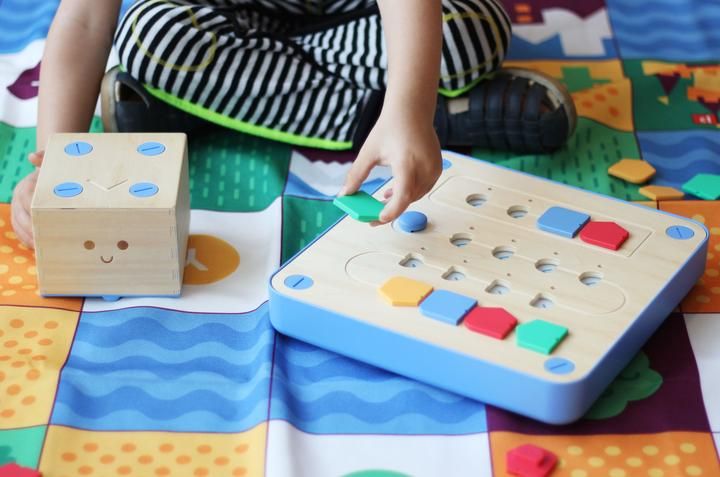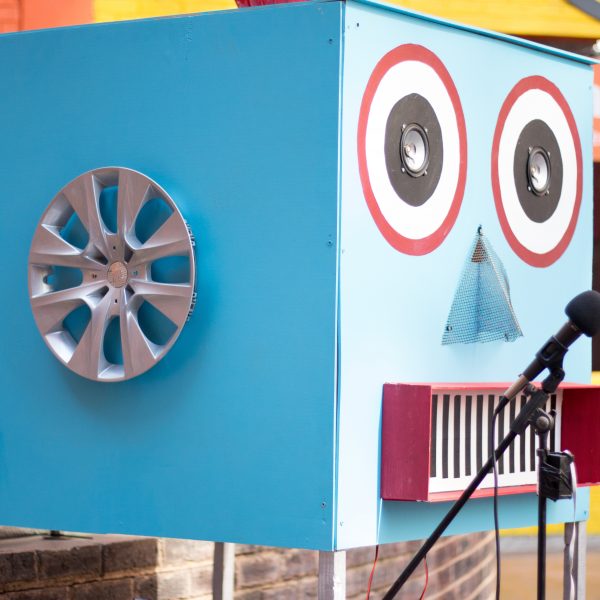Why kids under five must start learning to code

There’s a lot of pressure to learn coding in primary school to develop 21st century computational skills. But I think we should start in preschool.
Schools and governments recognise the need for teaching 21st century skills. We can see the evidence for that in the Australian Curriculum: Mathematics. But just as we teach preschool children the fundamentals of reading, we must now include computational thinking and coding.
While many early childhood services may have digital technologies, how they are presented and taught to young children, requires more focus and perhaps, upskilling of educators.
In my research we use cubettos (pictured). These are simple wooden square box robots with a smiley face that come with coding boards with colourful plastic pieces which make the robots move. We also uses bee-bots, small plastic bee-shaped robots with simple programming buttons on their backs, and blue-bots, clear cased bee-shaped robots that respond to commands sent from a computer or iPad.
I have been exploring how children learn to use them, and how educators support their use, as an extension to my PhD research. With 3-5 year olds, they realise that the pieces you put in the coding board, or the buttons you push, make the robots move in particular ways, and you can start explaining how they move and why they follow our commands.
Learning the basics of robotics at this age will set the foundation for primary school learning. It’s a great introduction to pre-maths, algorithms, counting and problem-solving: they learn this is the ‘recipe’ that moves the robots along.
While some early childhood education services have some robots to play with, what’s missing is the opportunity for richer learning that these devices offer.
Some educators will have a blue-bot or bee-bot and they might push the buttons to create a code for the children, but they’re not necessarily taking the next step to explaining the concept of coding.
The aim for my research is to think about the best way to equip educators to teach coding to pre-schoolers through play, for example whether it will be creating an instruction manual or workshop or something else.
Screens and play
Another aspect of technology is the use of screen technologies among the 3-5 year old age group, both real and replica or broken, which I call ‘imaginative’ technologies. Children want to use real technologies in play, but imaginative technologies are the next best thing. Children today live in a digital world and, given the opportunity, will readily use technology to meet their play needs.
Through my research, which has included interviewing 84 educators in the New England region alongside my colleague Dr Marg Rogers, I have found some educators are reluctant to incorporate real technologies into their classrooms for use by very young children.
Some educators and parents believe early use of technology will reduce their child’s creativity and imagination. Others encourage it. I have found with people holding such strong views, discussions on the subject can be a minefield.
Many services don’t provide real technology for children. They might use an iPad or camera, but it’s very controlled and directed, and the children are not given enough time with the technologies to develop skills and to learn.
The anxiety around using screens could also be further compounded and confused by current national guidelines on screen use.
National guidelines out of step
The current national guidelines recommend children under two are not exposed to any screen time. But this is really out of sync with home or modern life. So, it’s an interesting question for technology researchers like myself – do we follow the guidelines and not give technology to children? But children see technology and in their imaginative play, they want to copy what adults do.
They see people on phones, taking photos and typing on computers from an early age. How can you then have a ‘home corner’ in early childhood education centres that don’t have any of that? How many restaurants take orders on a phone or iPad? How can children re-enact what goes on in a restaurant without technology? Same with a doctor’s surgery or a supermarket. Technology is everywhere.
In a new research project, I will ask children aged 3-5 what they want in their imaginative play spaces and if they can make (out of recycled materials), what they need to in order to have an imaginative play space reflective of the real thing. For example, having iPads in a restaurant to take the orders or look up recipes. I believe real technologies also need to play a larger role in early childhood education.
And I don’t believe we can stop children accessing technologies.
I think it’s a bit disrespectful to not let children use technology in their play. How does it compute in their brains that technology is everywhere in their world, but they are not allowed to use or understand it? It must be confusing for them. I have found, educators need to support children’s technology use in positive ways. I’d like to see non screen-based coding, and iPads with select apps chosen for the learning that’s possible, including to document their own learning, in the preschool years.
Children need to learn how to use technologies and when it is appropriate to use them. Hopefully further research will help to guide the provision of technologies and guidelines for its use, support children’s ethical behaviour and reduce some of the discomfort educators and parents feel around the inclusion of working technologies in children’s lives.
Jo Bird is a senior lecturer at the University of New England, Armidale. Her PhD explored children’s use of digital technologies in imaginative play and the educators’ provision of the various devices, both working and imaginative. Her research interests include children’s play, the use of technologies by both children and educators and early childhood leadership. She loves presenting, both her research and inspiring others to use technologies in creative ways with children and to recognise their leadership worth.
This article was originally published on EduResearch Matters. Read the original article.
Popular

Quality
Practice
Provider
Research
ECEC in focus - Una Springwood’s intergenerational initiative brings young and old together through connection and care
2025-06-30 10:00:45
by Contributed Content

Provider
Practice
Quality
Research
Aboriginal Education Strategy drives early learning and school success in South Australia
2025-07-01 09:55:12
by Fiona Alston

Workforce
Policy
Quality
Research
Inclusive Practice Framework set to strengthen inclusion in early childhood settings
2025-06-24 11:37:00
by Isabella Southwell











